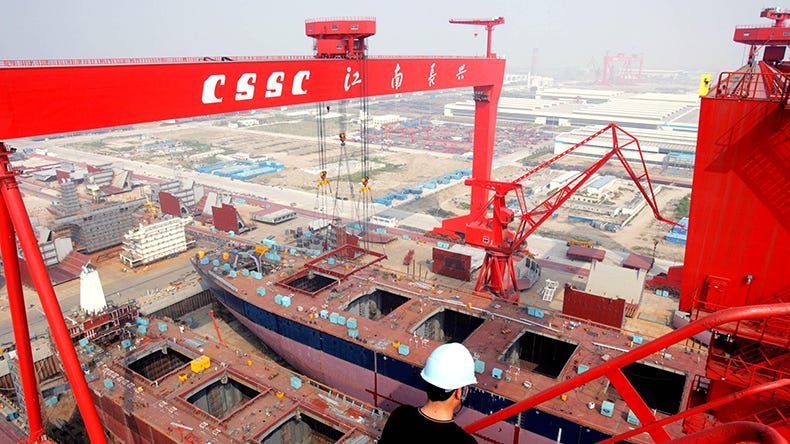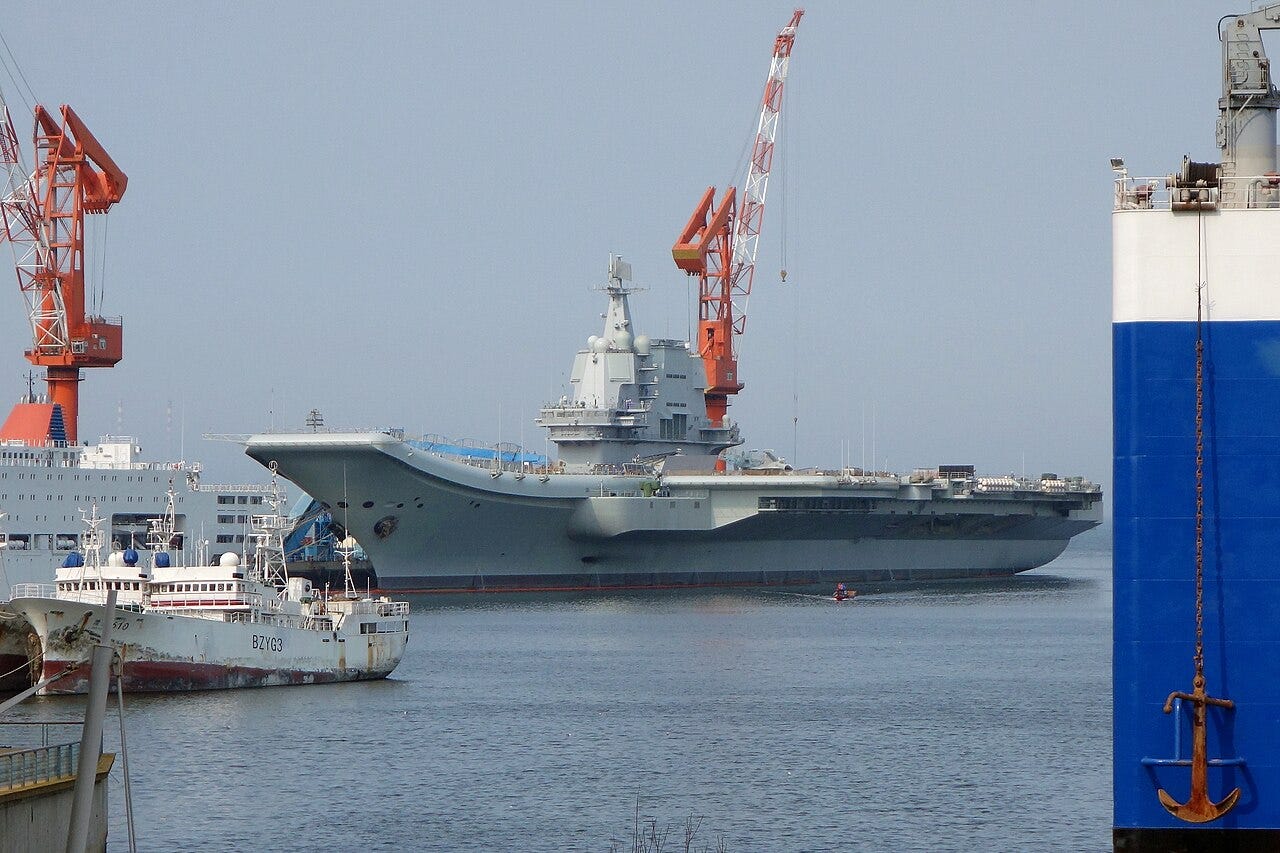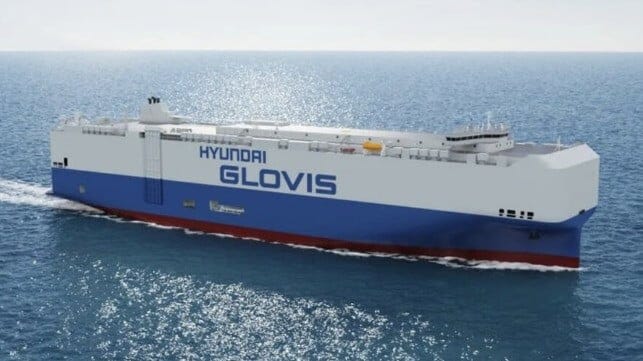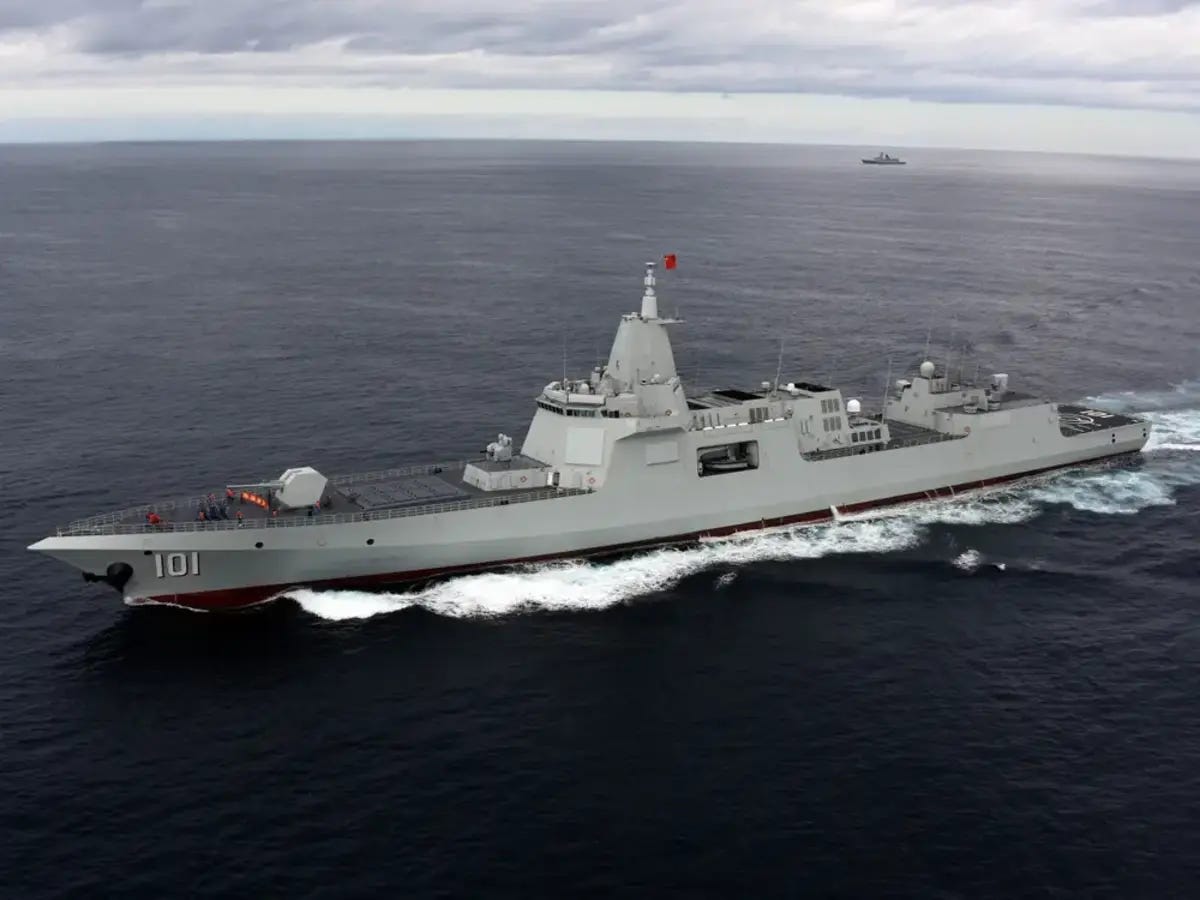China State Shipbuilding Corporation
Given the continued risk of a Chinese invasion of Taiwan, I thought I would explore Chinese shipbuilding capacity by looking at state-owned CSSC and its past decade of contributing to the expansion of the Chinese Navy—70 % of its over 300 vessels have been built since 2010.
The China State Shipbuilding Corporation (CSSC) is the world’s largest shipbuilder and one of the People’s Republic of China’s most vital defense entities. CSSC—a state-owned and directed company—owns the most important shipyards in China designed for the dual construction of military and civilian vessels and controls hundreds of maritime-related companies. It produces bulk cargo, LNG carriers, roll-on roll-off car transport vessels, cruise ships for commercial partners, and increasingly sophisticated military vessels for the People’s Liberation Army Navy (PLAN) and, in 2023, had a revenue of $52 billion USD, placing it on the Fortune 500 Global list.
CSSC has been at the forefront of the rise of the Chinese shipbuilding industry, which now produces more than the two next largest shipbuilding nations, Japan and South Korea, combined. Chinese shipbuilding’s astonishing growth, which from 2000 until 2010 saw Chinese deadweight ton (dwt) output rise 41% annually and its share of worldwide output reach 43.6% in 2023, has been heavily supported through state intervention. Driving this desire to build a modern shipbuilding industry is a politically driven aspiration to increase Chinese influence in international trade, support export-led economic growth, and build sufficient military capability to invade Taiwan and deter or defeat the US Navy if necessary.
As the primary champion of Chinese maritime construction, the story of CSSC’s rise highlights how dominant Chinese shipbuilding currently is. As Chinese naval capacity further increases, the ability of Western naval forces to deter a potential invasion of Taiwan will diminish, increasing the likelihood that Chinese leaders will risk an invasion to fulfill the long-held desire of finally uniting all of China under the leadership of the Communist Party.
Rise of a giant
Unlike many of China’s most influential and successful companies, such as Alibaba, BYD, and Tencent, CSSC has always been state-owned. CSSC was originally formed as the Sixth Ministry of Machine Building in 1964 - the seven other ministries included strategically essential industries such as aviation and nuclear). In 1982, the ministry was the first of the strategic sectors to be converted into a corporation as part of defense reforms instituted by Deng Xiaoping. Although the PLAN continued to operate some shipyards, principally for repairs, CSSC was now responsible for essentially all shipbuilding in China but continued to report to the State Council, the ultimate administrative body in the PRC. In 1999, CSSC was broken up into two holding companies to improve the efficiency of shipyards—although both companies remained under state control. After this split, CSSC took a smaller share of shipyards located in the more prosperous Southern and Eastern provinces, including the vast facilities in fast-growing Shanghai, such as the Jiangnan and Hudong Zhonghua, and other yards, including Huangpu Wenchong in Guangzhou and Wuchang in Wuhan. The Hudong Zhonghua shipyard is notable for constructing the first Chinese LNG carrier, launched in 2008 and in 2020, received the largest-ever contract for export LNG carriers with Qatar Energy, worth over $3bn.
Meanwhile, the newly created China Shipbuilding Industry Corporation (CSIC) was given assets in the northern provinces. It was given ownership of the Dalian shipyard on the Bohai Sea, which converted China’s first aircraft carrier purchased from the Soviets (the Liaoning, formally known as the Varyag). It also laid down the PLAN’s second carrier, Shandong, China’s first domestically produced aircraft carrier. More importantly, it received the custodianship of the Bohai shipyard in Laidong Bay, which is responsible for building nuclear-powered submarines, assembling six Type 094 ballistic missile submarines when CSSC and CSIC were split. These submarines are responsible for carrying the maritime component of the Chinese nuclear weapons force. Only five other countries—the US, UK, Russia, France, and India can construct nuclear submarines. The Bohai shipyard first launched a nuclear submarine, the Type 091 attack class, in 1974, nine years before the French navy was able to commission its first nuclear attack submarine.
Shandong, China’s first domestically produced aircraft carrier, can carry up to 36 aircraft, including 24 Shenyang J-15 multirole fighter aircraft.
While CSSC and CSIC were separate entities, CSIC received more revenue from constructing military vessels, reaching nearly double CSSC’s revenues from defense spending in 2019 at $12 billion for CSIC. These revenues were driven by a rapid expansion of the PLAN, growing from 216 combat ships in 2005, including aircraft carriers, cruisers, destroyers, frigates, and submarines, to 335 in 2019. Corruption in military contracts is common in China, and issues have plagued the Chinese military as the PLA saw officers routinely buying ranks and selling off logistical supplies. PLAAF personnel reportedly siphoned off jet fuel to cook hotpots. According to US intelligence sources, corruption is so bad in the PLA Rocket Force that fuel for missiles was never loaded but instead replaced with water, rendering the force responsible for the first wave of attacks on Taiwanese military infrastructure in the event of invasion unreliable or even useless.
Within shipbuilding, corruption tainted the research landscape: institutes operated with incomplete regulations, financial records were shrouded in secrecy, and bribery routinely secured research funding. Publicly funded projects were diverted for private gain, with resources and technology sold off for personal benefit. This culture of self-interest extended to nepotism, where individuals leveraged their positions to favor family and friends’ businesses, all while blatantly disregarding established party rules. At the head of CSIC was Hu Wenming, who became Chairman and Party Secretary. Partly as a consequence of his inability to limit corruption with CSIC and the consolidation of shipbuilding companies worldwide, the CSIC and CSSC merged again in 2019, creating the world’s largest shipbuilding company. Hu Wenming was arrested and disappeared from public view in 2020.
Currently, CSSC has a healthy order book for commercial and naval ships. Demand for LNG carriers has been growing since 2010 as US, Qatari, and Australian export potential increased in response to expanding supply and demand as countries move away from coal; the number of LNG carriers has grown from around 370 in 2010 to 734 at the end of 2022. While CSSC is a relatively new entrant to this market, it currently has the largest orders of any shipbuilder for new LNG carriers, partly due to a $3bn deal with Qatar Energy. Chinese LNG imports are expected to increase as China’s own demand for energy increases.
Rendering of the design of the Hyundai Glovis, a 10,000-unit RoRo ship to be built by CSSC.
CSSC has also received orders for roll-on-roll-off (RoRo) car carriers to export domestic giants BYD, Geely, and SAIC Motors’s electric vehicles worldwide. Although orders may be canceled, Chinese shipyards have potentially 200 orders of RoRo ships until 2036. RoRo vessels are notable because of their potential military applications. A ship that can deliver wheeled vehicles can also deliver tracked vehicles, wheeled armored personnel carriers, and supplies to conflict zones. Chinese RoRo vessels have been built to military specifications, with stern ramps to launch amphibious vehicles, highlighting them as a potential auxiliary force to supplement the PLAN’s own logistics capabilities. Chinese state television has shown the Chinese Marine Corps practicing loading and unloading ZBD-05 amphibious vehicles on RoRo vessels.
CSSC has also been constructing cruise vessels for the burgeoning Chinese tourism industry. While pleasure crafts may not seem to have military utility, their use in wartime would not be new. Olympia, the sister ship of the doomed Titanic, was used as a troopship in the First World War, and more recently, the British military used the luxury liners SS Canberra and Queen Elizabeth 2 to transport marines and soldiers to the Falklands War. CSSC has built one 136,000-ton cruise ship, the Adora Magic City, and has another under construction that could hold up to as many as 5300 troops to be sent as reinforcements to a conflict.
CSSC has built up significant capabilities in shipbuilding of all forms. Due to the strategic relevance of building military vessels, China’s shipbuilding industry would never compete internationally under free market conditions. The Chinese state uses various instruments to support CSSC and the wider shipbuilding industry. Direct subsidies for shipbuilding companies totaled $5 billion from 2010-2018 from the Ministry of Transportation and local governments. State-owned banks, such as the China Export-Import Bank (China Exim) and Bank of China, also provide generous loans (state-owned banks financed $127 billion of loans over the same period), with interest rates that average 0.5% less than loans made to privately owned Chinese firms. These loans are used not only to invest in upgrading shipyard facilities (Shanghai’s Changxing Island is in the process of building enormous new shipbuilding facilities, and the Hudong-Zhonghua yard is growing by 50%) but are made to both domestic and international firms purchasing ships so that orders can begin without needing more expensive private funding. Although state-backed financing is not unique to China, the scale far outstrips Western financial coordination—the China Exim provided $38 billion in export credits to Chinese firms in 2018, more than the next three largest credit agencies combined.
In the wake of the financial crisis and a downturn in ship construction, the CCP began a “scrap and build” subsidy worth billions of dollars to modernize fleets and keep companies such as CSSC building new vessels. This had the dual effect of adding more efficient and larger ships to Chinese shipping fleets while also squeezing foreign competition that could not compete with the volume produced by Chinese yards.
Indirect subsidies given to other industries feeding ship construction, such as steel production, also support CSSC. Chinese steel companies have received hundreds of billions of dollars in subsidies since the start of the millennium. Similar support is given to industries involved in ship construction, such as electricity and oil. Additionally, foreign firms are not allowed to operate by themselves in China and must “cooperate” with a Chinese firm.
Furthermore, cross-industry cooperation is facilitated by membership of the CCP. The CCP has required companies to allow party cells to operate at all levels since 1993, from shop floors to management. Senior company officials of large companies are sometimes made delegates to the National People’s Congress, the Chinese legislature. Embedding party members and officials within state and privately owned companies enables the CCP to oversee company management and allows directives and priorities to be dispersed throughout all levels of an organization so that it can understand the priorities of the CCP.
Chinese state support also includes the Chinese logistics support platform Logink, a supply chain platform that leverages data from a wide range of sources, including domestic and international ports, global logistics networks, users within China, and public databases around the world, to create what is claimed to be the most comprehensive picture of global logistics activity. It was first created as a provincial initiative in 2007 but expanded globally in 2014 and is provided free of charge to global ports, freight carriers, forwarders, and other countries. Over 20 ports, including eight European ports, currently have cooperation agreements. Although this service does not directly link with CSSC’s shipbuilding business, it does demonstrate how CSSC and Logink are a part of the wide-reaching strategy to dominate the international shipping trade, building both the ships on which goods travel and the logistics tools to understand when they will arrive. Logink could also pose a strategic risk by collecting information on other nations’ intentions and monitoring what they are shipping. The US military, for instance, utilizes commercial shipping to move logistical support and military equipment to its vast network of overseas bases and allies.
This expansion in capacity now means China can build 42 million dwt of shipping a year (compared to South Korea’s capacity of 23 million dwt and Japan’s 17 million dwt), has 20 large dockyards to facilitate repairs, and can continue to support the expansion of the PLAN.
What has CSSC built for the PLAN?
Chinese economic expansion has been accompanied by expanding military budgets, growing from $22.2 billion to $292 billion USD in 2022. In 2022, China spent more on defense than the next 17 Indo-Pacific economies combined. Although Chinese diplomats emphasize that this is less than half of the US military budget, which totaled $916 billion in 2023, when calculating for lower inputs, off-budget defense-related spending, and exchange rates, the Chinese military budget is closer to $471 billion. Importantly, China’s military is concentrated in one region, while the US maintains a presence worldwide.
At the turn of the millennium, the PLAN consisted of antiquated ships bought or copied from foreign designs. Since then, the PLAN fleet has seen significant upgrades—over 70% of China’s fleet has been launched since 2010 - adding three aircraft carriers with a further one under construction. While these are not nuclear-powered and carry a smaller complement of aircraft than US supercarriers, they demonstrate growing Chinese naval power. Their utility in invading Taiwan is questionable as Taiwan is already within range of fighters and missile attacks operating from the mainland. Still, they may pose a threat to the Taiwanese fleet if it attempts to break a blockade of the island or escape to link up with any reinforcing fleets.
One area in which the PLAN has been deficient compared to the US is the number of nuclear submarines (SSN). Conventional submarines (SNs), powered by diesel-electric batteries, have not been operated by the US since 1990, as they have a shorter endurance and carry fewer armaments, although they are significantly cheaper and can be quieter in shallow water, allowing them to avoid detection. However, CSSC has been building increasing numbers of SSNs that can range far from home waters and intercept supply lines. The latest PLAN SSN is the Type 093A submarine, the last of which was completed in 2018. A newer SSN, the Type 095, is currently under development. As China has large numbers of SNs and an invasion of Taiwan may not necessitate significant submarine forces deployed far from the mainland, it is unsurprising the PLAN has not prioritized more SSNs. Still, the US Navy is concerned about the production rate of Chinese submarines, and the growing SSN force is one reason behind the AUKUS agreement, where Australia will become the 7th nation to possess nuclear submarines to help the US Navy patrol the Pacific Ocean.
A Type 055 destroyer underway.
Of the 50 destroyers in active service in the PLAN, only four were commissioned prior to 2000, and 37 have been commissioned since 2010. These include the largest surface combatant built in Asia since the Second World War, the Type 055. Eight of these ships carry 112-cell modular Vertical Launch Systems (VLS) able to fire YJ-18 anti-ship cruise missiles and Y-21 hypersonic anti-ship ballistic missiles, reportedly capable of reaching targets over 900 miles away, a distance greater than Taipei to Nagasaki in Japan. Eight more of these large ships are under construction, and CSSC hopes to achieve an initial assembly to commissioning time of four years for this batch. Still, the mainstay of the PLAN fleet is 25 Type 052D destroyers, which are comparable to the US Navy’s Arleigh Burke, Royal Navy’s Daring, or the Japanese Maritime SDF Akizuki Class destroyers, carrying radar designed to protect the rest of the fleet. Type 052D Destroyers took four years to complete, matching the production rate of Arleigh Burkes. While the PLAN’s destroyers are currently not as advanced as Western-designed ships, quantity has its own quality. The US Seventh Fleet, responsible for East Asia, currently has 10 destroyers available. Although forces would be surged to East Asia in the event of a conflict, depending on the level of readiness, these ships could take weeks to arrive.
How can Western nations respond?
The United States has built an impressive and complex set of alliances and military relationships to ensure geopolitical stability. Previously, US allies who have accompanied the US on military interventions in the Middle East have principally been European nations, but as the principal target of Chinese expansionism is Taiwan, European nations cannot be counted upon to intervene. Only three European nations joined Operation Prosperity Guardian, the US-led coalition to secure the Bab el Mandeb strait into the Red Sea, partly due to political reservations and a lack of naval vessels. Although European nations could take over some duties patrolling the North Atlantic and Mediterranean, it is deeply unlikely that any European nation would send forces to defend Taiwan in the event of an invasion. If it wanted to defend Taiwan, the US would have to lean on its allies in Japan, Australia, and South Korea, none of whom have any commitment to defend Taiwan and would be wary of engaging in military conflict with China due to economic ties and the risk of a Chinese counterattack striking critical military installations and civilian population centers at home.
Although the chances of either South Korea or Japan getting involved in a military conflict over Taiwan are uncertain, both governments are taking steps to regain lost ground regarding commercial shipbuilding, investing in more advanced forms of shipping and more efficient and environmentally friendly engines. South Korea has launched a $7 billion fund to support investment in autonomous and zero-emission ships, as well as training 2000 extra shipbuilders and designers a year. Japan’s six major shipbuilders are collaborating on ammonia-fueled ships and battery tankers to try and capitalize on the International Maritime Organization’s target of net-zero greenhouse gas emissions from international shipping by or around 2050.
The list of allies the US could call upon in the event of war over Taiwan is short, and their likely response is unknown. Consequently, the US has been attempting to increase the number of ships available to the US Navy by extending the in-service periods of older ships, cutting non-essential ships to free up funding, and accelerating construction times. Unlike China, shipbuilding is concentrated among large military contractors who do not build civilian vessels. The US shipbuilding potential is 230 times smaller than China’s, with only seven large shipyards. High labor costs, a declining manufacturing base, and an inability to efficiently plan and execute ambitious state-led projects mean any improvement to US shipbuilding capabilities will take years, if not decades.
If the US wanted to rapidly increase the number of ships available, it could buy ships from efficient South Korean and Japanese yards. The prospects of this are slim, as 400,000 jobs are tied to the US shipbuilding industry, and established defense contractors Huntington Ingalls Industries and General Dynamics NASSCO would fiercely object with well-funded lobbyists. It would also be incredibly expensive at a time when budgets, although growing, are tight, with many other global priorities, not to mention the pressures of democratic decision-making. Even if funds were dedicated to building more ships, the US Navy would also have to solve the problems of a 20-year maintenance backlog that is currently causing some ships to be retired early or taken to sea in less than acceptable conditions. Finally, to crew these ships, the US would need to address the issue of manpower: all branches of the US military are currently failing to recruit sufficient personnel.
Conclusion
CSSC has built so many naval and commercial ships because the CCP leveraged China’s comparative advantage in heavy industry and significant state resources to turn their strategic priority into a reality. If the end goal is to mount an invasion of Taiwan, the PLAN has been given the resources to accomplish this goal, even if the current quality of its sailors and some of its equipment is questionable. One advantage of having a large navy is the training and learning opportunities that come from operating more often. As the PLAN continues to expand, its officers and men will gain more experience, catching up on the job to the professionalism of Western navies.
If the goal was simply to dominate shipbuilding and make world economies increasingly dependent on Chinese goods, this goal could be considered largely achieved. Not only is the world dependent on China for many key manufactured goods, but they are now also carried to market on Chinese-made ships, welded together by the 310,000 thousand workers of CSSC.
Constructing a large fleet takes decades, requires significant political willpower and a considerable industrial base. The US now lacks time and political urgency to significantly increase its naval forces. If Taiwan is to remain independent, it will be wiser to focus on lower-cost anti-access/area denial capabilities to deter the growing Chinese fleet.
If you enjoyed this, then please consider subscribing to my substack, where I do deep dives on geopolitical issues and globally relevant companies.




Executive summary: China State Shipbuilding Corporation (CSSC) has become the world’s largest shipbuilder through state support, enabling rapid expansion of China’s naval and commercial fleets and potentially increasing the risk of a Chinese invasion of Taiwan.
Key points:
CSSC has led China’s rise to dominate global shipbuilding, now producing more than Japan and South Korea combined.
Extensive state support through subsidies, loans, and political coordination has enabled CSSC’s growth.
CSSC has built 70% of China’s naval fleet since 2010, including aircraft carriers, nuclear submarines, and advanced destroyers.
China’s naval expansion outpaces Western capabilities, potentially shifting the balance of power regarding Taiwan.
The U.S. faces challenges in matching China’s shipbuilding capacity due to industrial and political constraints.
To deter Chinese naval power, Taiwan and allies may need to focus on cost-effective anti-access/area denial capabilities rather than matching fleet size.
This comment was auto-generated by the EA Forum Team. Feel free to point out issues with this summary by replying to the comment, and contact us if you have feedback.